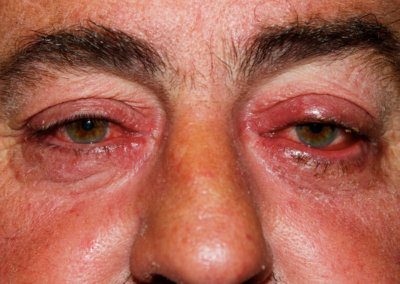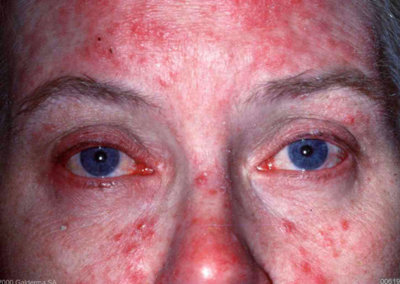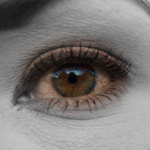Rosacea is a condition that affects many people. While it’s more common in fair-skinned women of any age, anyone can actually develop it. It’s generally characterized by a reddened face, and sometimes causes small red bumps, and can be often mistaken for acne, an allergic reaction, or other skin conditions.
Over time, the condition can become worse, if it isn’t given medical attention, as it tends to flare up for weeks, or even months, at a time, only to lessen again. There is no known cure, but treatment can certainly mitigate the effects.
Ocular rosacea is a condition that often develops in people who suffer from rosacea, causing burning, red, itchy eyes. On occasion, ocular rosacea is a sign of developing the other kind. As with all rosacea, it most often develops in people between the ages of 30 and 50, who have fair skin prone to blushing and redness. Medication can control the symptoms, but not cure them. It’s usual for the condition to return after a period of remission.
Ocular rosacea can develop slowly over time, with symptoms that can belong to a number of other eye conditions, like dry eyes, the feeling of grittiness or a foreign object in the eye, blurry vision, red eyes, or excessive tearing. It may happen when the skin condition is apparent, or may happen all on its own.
Parkinson’s disease is a much different disorder. Instead of the skin, it affects the nervous system, in particularly the ability to move. It often starts with minor tremors or stiffness in a hand. A loss of facial expressiveness, soft or slurred speech, and other symptoms may also develop. All these symptoms become worse as the condition continues.
There is no cure for Parkinson’s disease, but medical science has progressed to the point where the symptoms can be significantly reduced. It is known that the disease causes neurons in the brain to die, causing neurological degeneration, but no one really knows what the ultimate cause is. Researchers believe there may be genetic factors or certain triggers in the environment, much like any disorder with no known direct cause.
Parkinson’s tends to develop in older people, most commonly over 60, and most of these are men. As stated before, there are also genetic factors. Some researchers believe they have found another link.
The Link Between Parkinson’s and Ocular Rosacea
A Danish study published in JAMA Neurology suggests there may be some correlation between ocular rosacea and Parkinson’s disease. This is not cause for anyone with ocular rosacea to be unduly worried – instead it may be a step toward finding new ways to treat both disorders by coming to terms with whatever their ultimate causes might be.
The subjects of the study were every Danish adult over the age of eighteen, nearly five-and-a-half million people, with information tracked over more than a decade from 1997 to 2011. Information was taken from the Danish National Patient Registry, in order to find those with Parkinson’s, rosacea, or both. According to the findings, there was a lower age of onset as well as an increased risk of Parkinson’s in patients who were also living with rosacea.
An analysis of the data showed those with rosacea were about 1.7 times more likely to develop Parkinson’s disease than those without rosacea. Patients with ocular rosacea were just over twice as likely to show symptoms of Parkinson’s. Rosacea patients who developed Parkinson’s also tended to develop symptoms about two-and-a-half years earlier than those without rosacea.
While there seems to be a link of some kind, the researchers are not quite sure what the link is. One theory is the level of matrix metalloproteinase (MMP) in the patient’s system. Normally, MMPs are created to activate aspects of the immune system and help the body fight off infections. In rosacea patients, it is believed an over-production of MMPs create anti-bodies which can attack healthy cells, causing rosacea. Patients with rosacea and Parkinson’s or other disorders similar to Parkinson’s show they have extra production of MMPs.
It has been proven that additional activation of MMPs, anti-bacterial elements in the body, and rosacea are all linked; these peptides induce inflammation of the skin. The link to Parkinson’s implies MMPs also have a part to play in neurodegenerative diseases, including Parkinson’s disease. While the researchers have stated further studies are needed to confirm these findings, in the future they may lead not only to a way to stop outbreaks and recurrences of ocular rosacea, but to a means of arresting the development of Parkinson’s disease before it becomes debilitating.
——
Guest Author: Laura O’Donnell | EyeCare 20/20













We are pleased to let you know that we have added this article to the “Parkinson’s on Facebook” https://uk.pinterest.com/outthinkingpark/parkinsons-on-facebook/ – a Collaborative Pinterest Board between the Parkinson’s People https://www.facebook.com/Parkinsonspeople/ and Out-Thinking Parkinson’s https://www.facebook.com/outthinkingparkinsons Facebook Pages, sharing all things related to Parkinson’s Disease and its Management.